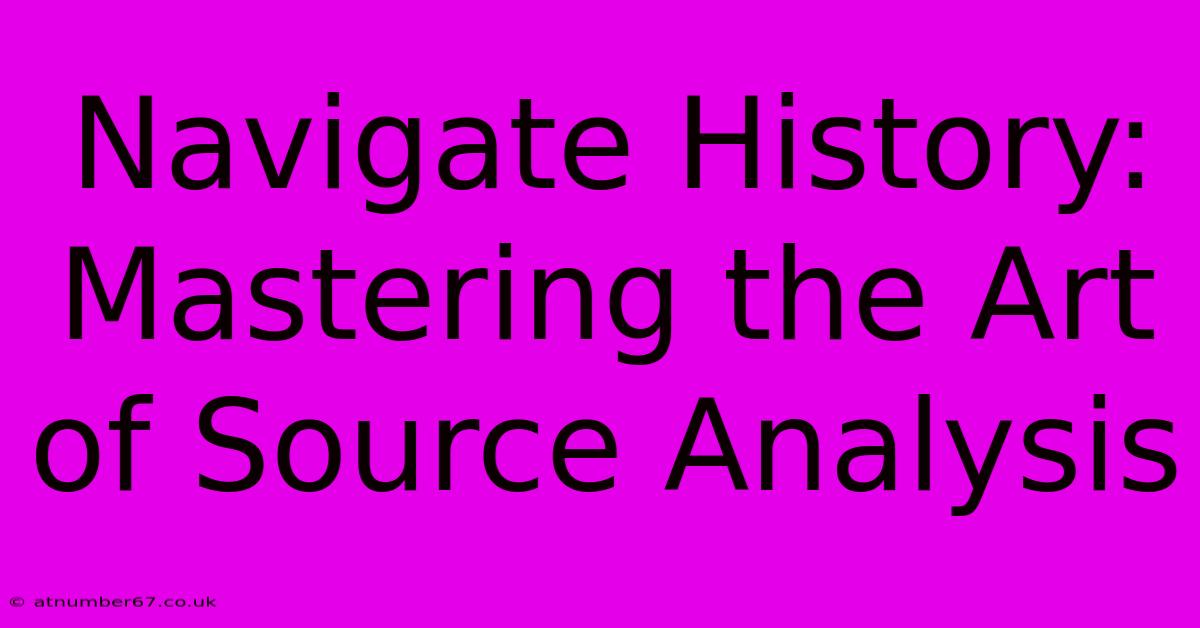Navigate History: Mastering The Art Of Source Analysis

Table of Contents
Navigate History: Mastering the Art of Source Analysis
History isn't just a collection of facts; it's a narrative woven from countless sources, each with its own biases, perspectives, and limitations. Mastering the art of source analysis is crucial for anyone navigating the complexities of the past, whether you're a student, a researcher, or simply a curious individual. This guide will equip you with the essential skills to critically examine historical sources and construct well-supported historical arguments.
Understanding the Source: The First Step to Effective Analysis
Before diving into interpretation, it's paramount to understand the context surrounding your source. Ask yourself these crucial questions:
1. Who Created the Source?
- Author's Identity: Knowing the author's background—their profession, social standing, beliefs, and experiences—is vital. A firsthand account from a peasant offers a vastly different perspective than one from a nobleman.
- Intended Audience: Who was the source created for? A personal diary intended for private reflection differs significantly from a public proclamation designed to influence opinion.
- Purpose: Why was the source created? Was it to inform, persuade, record events, or something else? Understanding the purpose helps uncover potential biases.
2. When and Where Was the Source Created?
- Historical Context: Consider the broader historical events surrounding the creation of the source. A letter written during wartime will likely reflect different concerns than one written during a period of peace.
- Geographic Location: The location of creation can also influence perspective and content.
3. What Type of Source Is It?
- Primary vs. Secondary Sources: Distinguishing between primary (created during the time period being studied) and secondary (created later, interpreting primary sources) sources is fundamental. Each offers unique insights, but understanding their differences is key to accurate analysis. Examples of primary sources include letters, diaries, photographs, and artifacts. Secondary sources include textbooks, biographies, and scholarly articles.
- Source Format: Is it a written document, an image, an artifact, or something else? The format itself can influence interpretation.
Analyzing the Content: Deconstructing Bias and Perspective
Once you understand the context, it's time to delve into the content itself. Look for:
1. Identifying Bias:
- Omitted Information: What information is missing? Are there gaps or inconsistencies that suggest deliberate omission?
- Loaded Language: Does the author use emotionally charged language or persuasive techniques?
- Perspective: Whose perspective is represented? Is it a singular viewpoint or a more balanced representation?
2. Corroboration and Comparison:
- Cross-Referencing: Compare your source with other sources from the same period. Do they corroborate each other, or do they present conflicting accounts?
- Multiple Perspectives: Seeking out diverse sources allows for a more nuanced understanding of historical events, avoiding reliance on a single, potentially biased account.
3. Evaluating Credibility:
- Source Reliability: Consider the source's potential for accuracy and trustworthiness. Is the author known for reliability? Are there any reasons to doubt its authenticity?
- Evidence: Does the source provide specific evidence to support its claims? Are those claims verifiable?
Building Your Historical Argument: Synthesis and Interpretation
After thorough analysis, you're ready to synthesize your findings and construct your historical argument.
1. Supporting Claims with Evidence:
Every claim you make should be supported by evidence from your analyzed sources. Direct quotes, paraphrases, and summaries should be properly cited.
2. Acknowledging Limitations:
Be aware of the limitations of your sources and acknowledge any potential biases or gaps in information. Transparency strengthens your argument.
3. Constructing a Narrative:
Weave your analysis into a coherent narrative that explains the historical context and the significance of your findings.
Conclusion: Becoming a Critical Historian
Mastering the art of source analysis is an ongoing process. It requires careful attention to detail, critical thinking, and a commitment to seeking out diverse perspectives. By employing the techniques outlined here, you'll be well-equipped to navigate the complexities of history and build well-supported, insightful arguments. Remember, the key is to approach historical sources with a critical and inquisitive eye, always questioning, comparing, and seeking to understand the full story.

Thank you for visiting our website wich cover about Navigate History: Mastering The Art Of Source Analysis. We hope the information provided has been useful to you. Feel free to contact us if you have any questions or need further assistance. See you next time and dont miss to bookmark.
Featured Posts
-
Alan Sugars Net Worth A Comprehensive Overview
Apr 02, 2025
-
Bugoy Carinos Age Celebrating A Life Well Lived
Apr 02, 2025
-
Christian Horner S Net Worth And His Family S Life
Apr 02, 2025
-
Is Ben Affleck Overrated Or Underestimated Net Worth
Apr 02, 2025
-
Lady Gaga Age Still Reigning Supreme At Age
Apr 02, 2025
